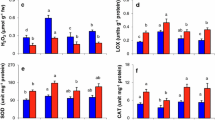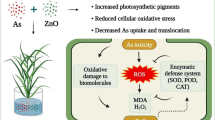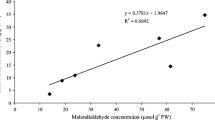Abstract
The toxic and non-essential metalloid arsenic (As) is ubiquitous in the environment with its absorption from the soil into the plants’ roots posing detrimental effects on the crop plants and hence the food availability and food security are also threatened. The present study was intended to reduce the As-induced toxicity in rice seedlings (Oryza sativa L.) by phosphate (PO43−). For this, three concentrations of potassium phosphate (KH2PO4), 50, 100 and 150 μM were supplemented along with 50 μM As exposure to hydroponically grown 7-day-old rice seedlings. Supplementation of PO43− significantly recovered arsenic-induced diminutions in growth parameters and photosynthetic pigment contents which were due to the significant increase in superoxide radical (SOR, O2•¯) and hydrogen peroxide (H2O2). Supplementation of 50 μM PO43− could significantly increase the activity of APX (ascorbate peroxidase) and GR (glutathione reductase) while 100 μM PO43− could increase the activity of DHAR (dehydroascorbate reductase) and monodehydroascorbate reductase (MDHAR). As the amount of PO43− was increased, the ratio of AsA/DHA (reduced to oxidized ascorbate) and GSH/GSSG (reduced to oxidized glutathione) was increased significantly due to increase in the reduced form of the non-enzymes i.e. AsA and GSH. The activity of SOD (superoxide dismutase) and GPX (guaiacol peroxidase) decreased significantly after a substantive increase in their activities due to As stress while the CAT (catalase) activity further enhanced after the supplementation of 50 and 100 μM PO43−. Thus, the As-induced oxidative stress in the rice seedlings was managed by concerted modulations in the activities of SOD, GPX, CAT and AsA-GSH cycle enzymes and metabolites.
Graphical abstract




Similar content being viewed by others
Availability of data and materials
Not applicable.
References
Abedin MJ, Meharg AA (2002) Relative toxicity of arsenite and arsenate on germination and early seedling growth of rice (Oryza sativa L.). Plant Soil 243:57–66
Adomako EE, Solaiman ARM, Williams PN, Deacon C, Rahman GKMM, Meharg AA (2009) Enhanced transfer of arsenic to grain for Bangladesh grown rice compared to US and EU. Environ Int 35:476–479
Aebi H (1974) Catalase. In: Bergmayer HU (ed) Methods of enzymatic analysis Verlag Chemie. Academic Press Inc, Weinheim/ NewYork, pp 673–680
Ahmad P, Alam P, Balawi TH, Altalayan FH, Ahanger MA, Ashraf M (2020) Sodium nitroprusside (SNP) improves tolerance to arsenic (As) toxicity in Vicia faba through the modifications of biochemical attributes, antioxidants, ascorbate-glutathione cycle and glyoxalase cycle. Chemosphere 244:125480
Ahsan N, Lee D-G, Kim K-H, Alam I, Lee S-H, Lee K-W, Lee H, Lee B-H(2010) Analysis of arsenic stress-induced differentially expressed proteins in rice leaves by two-dimensional gel electrophoresis coupled with mass spectrometry. Chemosphere. 78:224–231
Argos M, Kalra T, Rathouz PJ, Chen Y, Pierce B, Parvez F, Islam T, Ahmed A, Rakibuz-Zaman M, Hasan R, Sarwar G, Slavkovich V, VanGeen A, Graziano J, Ahsan H (2010) Arsenic exposure from drinking water, and all-cause and chronic-disease mortalities in Bangladesh (HEALS): a prospective cohort study. Lancet 376:252–258
Arthur JR (2000) The glutathione peroxidases. Cell Mol Life Sci 57:1825–1835
Beyer WF, Fridovich I (1987) Assaying for superoxide dismutase activity: some large consequences of minor changes in condition. Anal Biochem 161:559–566
Bhattacharya S, Sarkar ND, Banerjee P, Banerjee S, Mukherjee S, Chattopadhyay D, Mukhopadhyay A (2012) Effects of arsenic toxicity on germination, seedling growth and peroxidase activity in Cicer arietinum. Int J Agric Food Sci 2:131–137
Bradford MM (1976) A dye binding assay for protein. Anal Biochem 72:248–254
Brehe JE, Burch HB (1976) Enzymatic assay for glutathione. Anal Biochem 74:189–197
Castro-Mercado E, Martinez-Diaz Y, Roman-Tehandon N, Garcia-Pineda E (2009) Biochemical analysis of reactive oxygen species production and antioxidative responses in unripe avocado (Persea Americana Mill var Hass) fruits in response to wounding. Protoplasma 235:67–76
Choudhury B, Chowdhury S, Biswas AK (2011) Regulation of growth and metabolism in rice (Oryza sativa L.) by arsenic and its possible reversal by phosphate. J Plant Interact 6:15–24
Drazkiewicz M, Skorzynska-Polit E, Krupa Z (2003) Responses of the ascorbate glutathione cycle to excess copper in Arabidopsis thaliana (L.). Plant Sci 164:195–202
Duman F, Ozturk F, Aydin Z (2010) Biological responses of duckweed (Lemna minor L.) exposed to the inorganic arsenic species As(III) and As(V): effects of concentration and duration of exposure. Ecotoxicology 19:983–993
Fuhua C, Weiqi C, Shugui D (1994) Toxicities of four arsenic species to Scenedesmus obliquus and influence of phosphate on inorganic arsenic toxicities. Environ Toxicol Chem 41:1–7
Garg N, Singla P (2011) Arsenic toxicity in crop plants: physiological effects and tolerance mechanisms. Environ Chem Lett 9:303–321
Gossett DR, Millhollon EP, Cran LM (1994) Antioxidant response to NaCl stress in salt-sensitive cultivars of cotton. Crop Sci 34:706–714
Hasanuzzaman M, Mahmud JA, Nahar K, Anee TI, Inafuku M, Oku H, Fujita M (2017) Responses, adaptation, and ROS metabolism in plants exposed to waterlogging stress. In: Khan MIR, Khan NA (eds) Reactive oxygen species and antioxidant systems in plants: role and regulation under abiotic stress. Springer, Singapore, pp 257–281
Heath RL, Packer L (1968) Photoperoxidation in isolated chloroplasts: I. kinetics and stoichiometry of fatty acid peroxidation. Arch Biochem Biophys 125:189–198
Hewitt EJ (1966) Sand and water culture methods used in the study of plant nutrition. Technical Communication No. 22 of the Commonwealth Bureau of Horticulture and Plantation Crops. Farnham Royal, Bucks, England: The Commonwealth Agricultural Bureau. London.
Hossain MA, Bhattacharjee S, Armin S-M, Qian P, Xin W, Li H-Y, Burritt DJ, Fujita M, Tran L-SP(2015) Hydrogen peroxide priming modulates abiotic oxidative stress tolerance: insights from ROS detoxification and scavenging. Front Plant Sci 6:420
Ighodaro OM, Akinloye OA (2017) First line defence antioxidants-superoxide dismutase (SOD), catalase (CAT) and glutathione peroxidase (GPX): their fundamental role in the entire antioxidant defence grid. Alexandria J Med 54(4):287–293
Imran MA, Khan RM, Ali Z, Mahmood T (2013) Toxicity of arsenic (As) on seed germination of sunflower (Helianthus annuus L.). Int J Phys Sci 8:840–847
Jain M, Gadre RP (2004) Inhibition of 5-amino levulinic acid dehydratase activity by arsenic in excised etiolated maize leaf segments during greening. J Plant Physiol 161:251–255
Jin JWX, Huang YF (2010) Protective effect of nitric oxide against arsenic-induced oxidative damage in tall fescue leaves. Afr J Biotechnol 9:1619–1627
Jung HI, Kong MS, Lee BR, Kim TH, Chae MJ, Lee EJ, Jung GB, Lee CH, Sung JK, Kim YH (2019) Exogenous glutathione increases arsenic translocation into shoots and alleviates arsenic-induced oxidative stress by sustaining ascorbate–glutathione homeostasis in rice seedlings. Front Plant Sci 10:1089
Kato M, Shimizu S (1987) Chlorophyll metabolism in higher plants. VII. Chlorophyll degradation in senescing tobacco leaves; phenolic dependent peroxidative degradation. Can J Bot 65:729–735
Kumar N, Mallick S, Yadava RN, Singh AP, Sinha S (2013)Co-application of selenite and phosphate reduces arsenite uptake in hydroponically grown rice seedlings: toxicity and defence mechanism. Ecotoxicol Environ Saf 91:171–179
Lichtenthaler HK (1987) Chlorophyll and carotenoids: pigments of photosynthetic biomembranes. Methods Enzymol 148:350–382
Li-gang H, Wen-fuchen Guo-chen Z, Wei M, Chun-yan Q, Liang L, Hong-jia S (2012) Effects of phosphate fertilizer on cold tolerance and its related physiological parameters in rice under low temperature stress. J Northeast Agric Univ 4:1–10
Meharg AA, Hartley-Whitaker J (2002) Arsenic uptake and metabolism in arsenic resistant and non-resistant plant species. New Phytol 154:29–43
Mi L, Niu X, Lu M, Ma J, Wu J, Zhou X (2014)Phosphine-induced physiological and biochemical responses in rice seedlings. Chemosphere 100:77–82
Mishra RK, Kumar J, Srivastava PK, Bashri G, Prasad SM (2016) PS II Photochemistry, oxidative damage and anti-oxidative enzymes in arsenate-stressedOryza sativa L. Seed Chem Ecol 165:58–70
Mittler R (2002) Oxidative stress, antioxidants and stress tolerance. Trends Plant Sci 7:405–410
Muehe EM, Eisele JF, Daus B, Kappler A, Harter K, Chaban C (2014) Are rice (Oryza sativa L.) phosphate transporters regulated similarly by phosphate and arsenate? A comprehensive study. Plant Mol Biol 85:301–316
Naeem M, Khan MMA (2009) Phosphorus ameliorates crop productivity, photosynthesis, nitrate reductase activity and nutrient accumulation in Coffee senna (Senna Occidentalis L.) under phosphorus-deficient soil. J Plant Interact 4:145–153
Nakano Y, Asada K (1981) Hydrogen peroxide is scavenged by ascorbate specific peroxidase in spinach chloroplasts. Plant Cell Physiol 22:867–880
Neidhardt H, Kramar U, Tang GH, Norra S (2015) Arsenic accumulation in the roots of Helianthus annuus and Zea mays by irrigation with arsenic-rich groundwater: insights from synchrotron X-ray fluorescence imaging. Chem der Erde Geochem 75:261–270
Patra M, Bhowmik N, Bandopadhyay B, Sharma A (2004) Comparison of mercury, lead and arsenic with respect to genotoxic effects on plant systems and the development of genetic tolerance. Ecotoxicol Environ Saf 52:199–223
Pigna M, Cozzalino V, Violante A, Meharg AA (2009) Influence of phosphate on the arsenic uptake by wheat (Triticum durum L.) irrigated with arsenic solutions at three different concentrations. Water Air Soil Pollut 197:371–380
Rai A, Tripathi P, Dwivedi S, Dubey S, Shri M, Kumar S, Tripathi PK, Dave R, Kumar A, Singh R, Adhikari B, Bag M, Tripathi RD, Trivedi PK, ChakrabartyD TR (2011) Arsenic tolerances in rice (Oryza sativa) have a predominant role in transcriptional regulation of a set of genes including sulphur assimilation pathway and antioxidant system. Chemosphere 82:986–995
Saed-Moucheshi A, Pakniyat H, Pirasteh-Anosheh H, Azooz MM (2014a) Role of ROS as signaling molecules in plants. In: Parvaiz Ahmad (Ed.), Oxidative damage to plants: antioxidant networks and signaling. Academic Press, pp. 585-620.
Saed-Moucheshi A, Shekoofa A, Pessarakli M (2014b) Reactive oxygen species (ROS) generation and detoxifying in plants. J Plant Nutr 37:1573–1585
Saifullah, Dahlawi S, Naeem A, Iqbal M, Farooq MA, Bibi S, Rengel Z (2018) Opportunities and challenges in the use of mineral nutrition for minimizing arsenic toxicity and accumulation in rice: a critical review. Chemosphere 194:171–188
Sanglard LMVP, Detmann KC, Martins SCV, Teixeira RA, Pereira LF, Sanglard ML, Fernie AR, Araújo WL, DaMatta FM (2016) The role of silicon in metabolic acclimation of rice plants challenged with arsenic. Environ Exp Bot 123:22–36
Shakeri E, Mozafari AA, Sohrabi F, Saed-Moucheshi A (2019) Role of proline and other osmoregulatory compounds in plant responses to abiotic stresses. In: Pessarakli M (ed) Handbook of plant and crop stress, 4th edn. CRC Press Boca Raton, Boca Raton, pp 165–173
Sharma P, Jha AB, Dubey RS, Pessarakli M (2012) Reactive oxygen species, oxidative damage, and antioxidative defense mechanism in plants under stressful conditions. J Bot 2012:217037
Shri M, Kumar S, Chakrabarty D, Trivedi PK, Mallick S, Misra P, Shukla D, Mishra S, Srivastava S, Tripathi RD, Tuli R (2009) Effect of arsenic on growth, oxidative stress and antioxidant system in rice seedlings. Ecotoxicol Environ Saf 72:1102–1110
Singh R, Parihar P, Prasad SM (2020) Sulphur and calcium attenuate arsenic toxicity in Brassica by adjusting ascorbate–glutathione cycle and sulphur metabolism. Plant Growth Regul 91:221–235
Singh R, Singh S, Parihar P, Singh VP, Prasad SM (2015) Arsenic contamination, consequences and remediation techniques: a review. Ecotoxicol Environ Saf 112:247–270
Sinha S, Sinam G, Mishra RK, Mallick S (2010) Metal accumulation, growth, antioxidants and oil yield of Brassica juncea L. exposed to different metals. Ecotoxicol Environ Saf 73:1352–1361
Smith IK, Vierheller TL, Thurne CA (1988) Assay of glutathione reductase in crude tissue homogenates using 5,5 dithiobis2-nitrobenzoic acid. Anal Biochem 175:408–413
Srivastava M, Ma LQ, Singh N, Singh S (2005) Antioxidant responses of hyperaccumulator and sensitive fern species to arsenic. J Exp Bot 56:1332–1342
Srivastava PK, Singh VP, Prasad SM (2012) Compatibility of ascorbate-glutathione cycle enzymes in cyanobacteria against low and high UV-B exposures, simultaneously exposed to low and high doses of chlorpyrifos. Ecotoxicol Environ Saf 74:79–88
Srivastava S, Sharma YK (2013) Impact of arsenic toxicity on black gram and its amelioration using phosphate. ISRN Toxicol 2013:340925
Stoeva N, Bineva T (2003) Oxidative changes and photosynthesis in oat plants grown in As-contaminated soil. Bulgarian J Plant Physiol 29:87–95
Su YH, McGrath SP, Zhu Y, Zhao FJ (2008) Highly efficient xylem transport of arsenite in the arsenic hyperaccumulator Pteris vittata. New Phytol 180:434–441
Talukdar D (2013)Arsenic-induced oxidative stress in the common bean legume, Phaseolus vulgaris L. seedlings and its amelioration by exogenous nitric oxide. Physiol Mol Biol Plants 19:69–79
Thordal-Christensen H, Zhang Z, Wei Y, Collinge DB (1997) Subcellular localization of H2O2 in plants. H2O2 accumulation in papillae and hypersensitive response during the barley— powdery mildew interaction. Plant J 11:1187–1194
Tullio MCD, Gara LD, Paciolla C, Arrigoni O (1998) Dehydroascorbate reducing proteins in maize are induced by the ascorbate biosynthesis inhibitor lycorine. Plant Physiol Biochem 36:433–440
Velikova V, Yordanov I, Edreva A (2000) Oxidative stress and some antioxidant system in acid rain-treated bean plants. Plant Sci 151:59–66
Wu C, Ye Z, Shu W, Zhu Y, WongM (2011) Arsenic accumulation and speciation in rice are affected by root aeration and variation of genotypes. J Exp Bot 62:2889–2898
Yadav G, Srivastava PK, Singh VP, Prasad SM (2014) Light intensity alters the extent of arsenic toxicity in Helianthus annuus L. Seed Biol Trace Elem Res 158:410–421
Zakhar R, Derco J, Čacho F (2018) An overview of main arsenic removal technologies. Acta Chim Slov 11:107–113
Zhao FJ, McGrath SP, Meharg AA (2010) Arsenic as a food chain contaminant: mechanisms of plant uptake and metabolism and mitigation strategies. Annu Rev Plant Biol 61:535–559
Zvobgo G, WaLwalaba JL, Sagonda T, Mapodzeke JM, Muhammad N, Shamsi IH, Zhang G (2018) Phosphate alleviates arsenate toxicity by altering expression of phosphate transporters in the tolerant barley genotypes. Ecotoxicol Environ Saf 147:832–839
Acknowledgements
The Head, Department of Botany, University of Allahabad, India is gratefully acknowledged for providing necessary laboratory facilities.
Funding
The authors are obliged to the University Grants Commission, New Delhi for the award of Dr. D. S. Kothari Postdoctoral Fellowship Scheme-F 4-2/2006 (BSR)/13-113/2013 (BSR) to Rohit Kumar Mishra.
Author information
Authors and Affiliations
Contributions
Rohit Kumar Mishra designed the experiment, analyzed the data, interpreted the results and wrote the manuscript. Gitanjali Mishra sketched the graphical abstract and helped in manuscript preparation. Parul Parihar, Rachana Singh and Jitendra Kumar accomplished the experiment. Prabhat Kumar Srivastava and Sheo Mohan Prasad reviewed and improved the manuscript. The final version of the manuscript has been seen and agreed by all the authors.
Corresponding authors
Ethics declarations
Ethics approval and consent to participate
Not applicable.
Consent for publication
Not applicable.
Competing interests
The authors declare no competing interests.
Additional information
Responsible Editor: Gangrong Shi
Publisher’s note
Springer Nature remains neutral with regard to jurisdictional claims in published maps and institutional affiliations.
Highlights
• Arsenic stress induces diminutions in growth attributes and photosynthetic pigments.
• Arsenic stress provokes oxidative burst in rice seedlings.
• The histochemical analysis of ROS proves the severe oxidative stress experienced by rice seedlings.
• The supplementation of PO43− strengthened the compatibility of ascorbate-glutathione(AsA-GSH) cycle.
• The application of PO43− fortified the antioxidative defence system against ROS.
Supplementary information
ESM 1
(DOCX 22 kb)
Rights and permissions
About this article
Cite this article
Mishra, R.K., Mishra, G., Singh, R. et al. Managing arsenic (V) toxicity by phosphate supplementation in rice seedlings: modulations in AsA-GSH cycle and other antioxidant enzymes. Environ Sci Pollut Res 29, 14418–14429 (2022). https://doi.org/10.1007/s11356-021-16587-3
Received:
Accepted:
Published:
Issue Date:
DOI: https://doi.org/10.1007/s11356-021-16587-3




